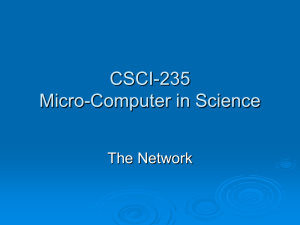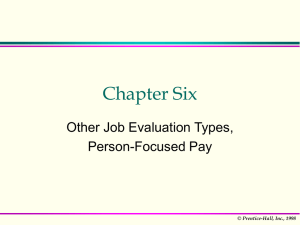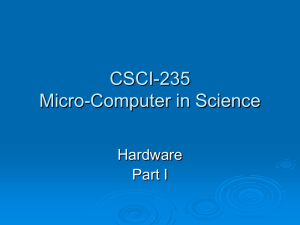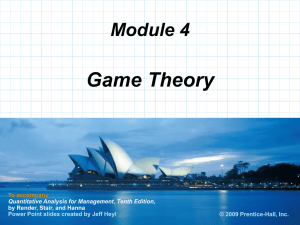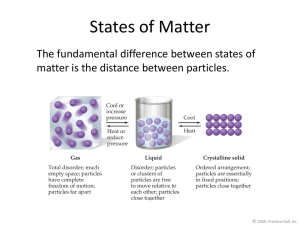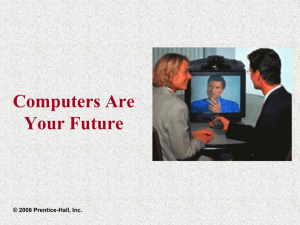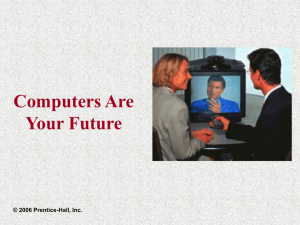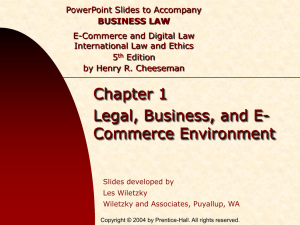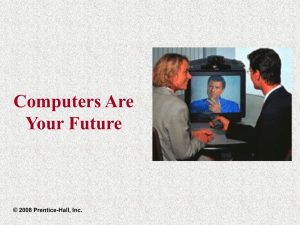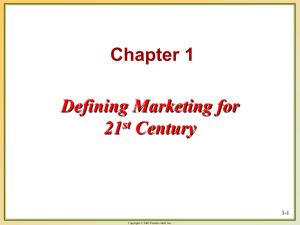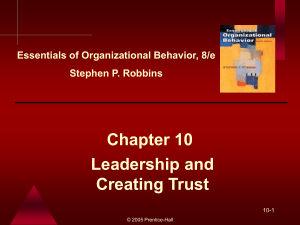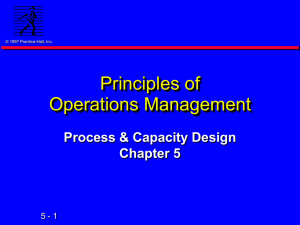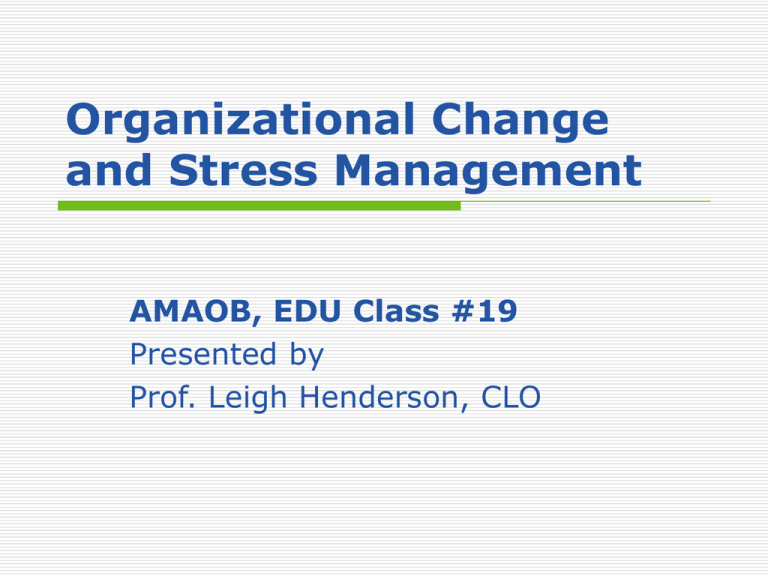
Organizational Change
and Stress Management
AMAOB, EDU Class #19
Presented by
Prof. Leigh Henderson, CLO
Chapter Learning Objectives
Identify forces/stimulants to change.
Contrast planned and unplanned change.
List the forces for resistance to change.
Compare approaches to change.
Review ways to create culture for change.
Define stress, sources, consequences.
Individual and organizational approaches.
Explain global differences in organizational change and
work stress.
© 2009 Prentice-Hall Inc. All rights reserved.
19-2
Change or Die? Change and Die?
Evolution of Circuit City
History
Competition
Successes
Decisions
Challenges
Results
Forces for Change
Nature of the Workforce
Greater diversity.
Technology
Faster, cheaper, more mobile.
Economic Shocks
Mortgage meltdown.
Competition
Global marketplace.
Social Trends
Baby boom retirements.
World Politics
Iraq War and the opening of China.
© 2009 Prentice-Hall Inc. All rights reserved.
19-4
Planned Change
Change
Making things different.
Planned Change
Activities that are proactive and purposeful: an
intentional, goal-oriented activity.
Goals of planned change
Improving the ability of the organization to adapt to
changes in its environment.
Changing employee behavior.
Change Agents
Persons who act as catalysts and assume the
responsibility for managing change activities.
© 2009 Prentice-Hall Inc. All rights reserved.
19-5
Resistance to Change
Resistance to change appears to be a natural
and positive state.
Forms of Resistance to Change:
Overt and Immediate
Voicing complaints, engaging in job actions.
Implicit and Deferred
Loss of employee loyalty and motivation, increased errors
or mistakes, increased absenteeism.
Deferred resistance clouds the link between source and
reaction.
© 2009 Prentice-Hall Inc. All rights reserved.
19-6
Sources of Resistance to
Change
E X H I B I T 19-2
© 2009 Prentice-Hall Inc. All rights reserved.
19-7
Tactics for Overcoming
Resistance to Change
Education and Communication
Show those effected the logic behind the change.
Participation
Participation in the decision process lessens resistance.
Building Support and Commitment
Counseling, therapy, or new-skills training.
Implementing Change Fairly
Be consistent and procedurally fair.
Manipulation and Cooptation
“Spinning” the message to gain cooperation.
Selecting people who accept change
Hire people who enjoy change in the first place.
Coercion: Direct threats and force
© 2009 Prentice-Hall Inc. All rights reserved.
19-8
The Politics of Change
Impetus for change is likely to come from
outside change agents, new employees, or
managers outside the main power structure.
Internal change agents are most threatened by
their loss of status in the organization.
Long-time power holders tend to implement
incremental but not radical change.
The outcomes of power struggles in the
organization will determine the speed and
quality of change.
© 2009 Prentice-Hall Inc. All rights reserved.
19-9
Lewin’s Three-Step Change
Model
Unfreezing
Change efforts to overcome the pressures of both
individual resistance and group conformity
Refreezing
Stabilizing a change intervention by balancing driving
and restraining forces
Unfreeze
Move
Refreeze
E X H I B I T 19-3
© 2009 Prentice-Hall Inc. All rights reserved.
19-10
Lewin: Unfreezing the Status
Quo
Driving Forces
Forces that direct behavior away from the status quo
Restraining Forces
Forces that hinder movement from the existing
equilibrium.
E X H I B I T 19-4
© 2009 Prentice-Hall Inc. All rights reserved.
19-11
Kotter’s Eight-Step Plan
Builds from Lewin’s Model
To implement change:
1.
2.
3.
4.
5.
6.
7.
8.
Establish a sense of urgency
Form a coalition
Create a new vision
Communicate the vision
Empower others by removing barriers
Create and reward short-term “wins”
Consolidate, reassess, and adjust
Reinforce the changes
Unfreezing
Movement
Refreezing
E X H I B I T 19-5
© 2009 Prentice-Hall Inc. All rights reserved.
19-12
Action Research
A change process based on systematic collection of data
and then selection of a change action based on what the
analyzed data indicates
Process steps:
1. Diagnosis
2. Analysis
3. Feedback
4. Action
5. Evaluation
Action research benefits:
Problem-focused rather than solution-centered.
Heavy employee involvement reduces resistance to
change.
© 2009 Prentice-Hall Inc. All rights reserved.
19-13
Organizational Development
Organizational Development (OD)
A collection of planned interventions, built on
humanistic-democratic values, that seeks to improve
organizational effectiveness and employee well-being
OD Values
Respect for people
Trust and support
Power equalization
Confrontation
Participation
© 2009 Prentice-Hall Inc. All rights reserved.
19-14
Six OD Techniques
1. Sensitivity Training
Training groups (T-groups) that seek to change behavior
through unstructured group interaction
Provides increased awareness of others and self
Increases empathy with others, listening skills, openness,
and tolerance for others
2. Survey Feedback Approach
The use of questionnaires to identify discrepancies among
member perceptions; discussion follows and remedies are
suggested
3. Process Consultation (PC)
A consultant gives a client insights into what is going on
around the client, within the client, and between the client
and other people; identifies processes that need to improve.
© 2009 Prentice-Hall Inc. All rights reserved.
19-15
Six OD Techniques (Continued)
4. Team Building
High interaction among team members to increase
trust and openness.
5. Intergroup Development
OD efforts to change the attitudes, stereotypes, and
perceptions that groups have of each other.
6. Appreciative Inquiry
Seeks to identify the unique qualities and special
strengths of an organization, which can then be built
on to improve performance.
Discovery: Recalling the strengths of the organization.
Dreaming: Speculation on the future of the organization.
Design: Finding a common vision.
Destiny: Deciding how to fulfill the dream.
© 2009 Prentice-Hall Inc. All rights reserved.
19-16
Creating a Culture for Change:
Innovation
1. Stimulating a Culture of Innovation
Innovation: a new idea applied to initiating or
improving a product, process, or service.
Sources of Innovation:
Structural variables: organic structures
Long-tenured management
Slack resources
Interunit communication
Idea Champions: Individuals who actively promote
the innovation.
© 2009 Prentice-Hall Inc. All rights reserved.
19-17
Creating a Culture for Change:
Learning
2. Learning Organization
An organization that has developed the continuous
capacity to adapt and change.
Learning Types
Single-Loop: errors are corrected using past routines.
Double-Loop: errors are corrected by modifying routines.
Characteristics
Holds a shared vision.
Discards old ways of thinking.
Views organization as system of relationships.
Communicates openly.
Works together to achieve shared vision
E X H I B I T 19-6
© 2009 Prentice-Hall Inc. All rights reserved.
19-18
Creating a Learning
Organization
Overcomes traditional organization problems:
Fragmentation
Competition
Reactiveness
Manage Learning by:
Establishing a strategy.
Redesigning the organization’s structure.
Flatten structure and increase cross-functional activities
Reshaping the organization’s culture.
Reward risk-taking and intelligent mistakes.
© 2009 Prentice-Hall Inc. All rights reserved.
19-19
Work Stress
Stress
A dynamic condition in which an individual is
confronted with an opportunity, constraint, or demand
related to what he or she desires and for which the
outcome is perceived to be both uncertain and
important.
Types of Stress
Challenge Stressors
Stress associated with workload, pressure to complete
tasks, and time urgency.
Hindrance Stressors
Stress that keeps you from reaching your goals, such as
red tape.
Cause greater harm than challenge stressors.
© 2009 Prentice-Hall Inc. All rights reserved.
19-20
Demands-Resources Model of
Stress
Demands
Responsibilities, pressures, obligations, and
uncertainties in the workplace.
Resources
Things within an individual’s control that can be used
to resolve demands.
Adequate resources help reduce the stressful
nature of demands
© 2009 Prentice-Hall Inc. All rights reserved.
19-21
A Model of Stress
E X H I B I T 19-8
© 2009 Prentice-Hall Inc. All rights reserved.
19-22
Potential Sources of Stress
Environmental Factors
Economic uncertainties of the business cycle.
Political uncertainties of political systems.
Technological uncertainties of technical innovations.
Organizational Factors
Task demands related to the job.
Role demands of functioning in an organization.
Interpersonal demands created by other employees.
Personal Factors
Family and personal relationships.
Economic problems from exceeding earning capacity.
Personality problems arising from basic disposition.
© 2009 Prentice-Hall Inc. All rights reserved.
19-23
Consequences of Stress
Stressors are additive: high levels of stress can
lead to the following symptoms
Physiological
Blood pressure, headaches, stroke.
Psychological
Dissatisfaction, tension, anxiety, irritability, boredom, and
procrastination.
Greatest when roles are unclear in the presence of
conflicting demands.
Behavioral
Changes in job behaviors, increased smoking or drinking,
different eating habits, rapid speech, fidgeting, sleep
disorders.
© 2009 Prentice-Hall Inc. All rights reserved.
19-24
Not All Stress Is Bad
Some level of stress can increase productivity.
Too little or too much stress will reduce
performance.
This model is not empirically supported.
E X H I B I T 19-9
© 2009 Prentice-Hall Inc. All rights reserved.
19-25
Managing Stress
Individual Approaches
Implementing time management.
Increasing physical exercise.
Relaxation training.
Expanding social support network.
Organizational Approaches
Improved personnel selection and job placement.
Training.
Use of realistic goal setting.
Redesigning of jobs.
Increased employee involvement.
Improved organizational communication.
Offering employee sabbaticals.
Establishment of corporate wellness programs.
© 2009 Prentice-Hall Inc. All rights reserved.
19-26
Global Implications
Organizational Change
Culture varies people’s belief in the possibility of
change.
Time orientation will affect implementation of change.
Reliance on tradition can increase resistance to
change.
Power distance can modify implementation methods.
Idea champions act differently in different cultures.
Stress
Job conditions that cause stress vary across cultures.
Stress itself is bad for everyone.
Having friends and family can reduce stress.
© 2009 Prentice-Hall Inc. All rights reserved.
19-27
Summary and Managerial
Implications
Organizations and the individuals within them
must undergo dynamic change.
Managers are change agents and modifiers of
organizational culture.
Stress can be good or bad for employees.
Despite possible improvements in job
performance caused by stress, such
improvements come at the cost of increased job
dissatisfaction.
© 2009 Prentice-Hall Inc. All rights reserved.
19-28
Ethical Dilemma: Stressing Out
Employees is Your Job
Do you think there is a trade-off between the
positive (higher performance) and negative
(increased stress) of stretch goals?
Yes? No? Explain your answer.
Do you think a manager should consider stress
when setting stretch goals for employees?
Yes? No? Explain your answer.
How do you think you would respond to
respond to stretch goals?
Yes? No? Explain your answer.

